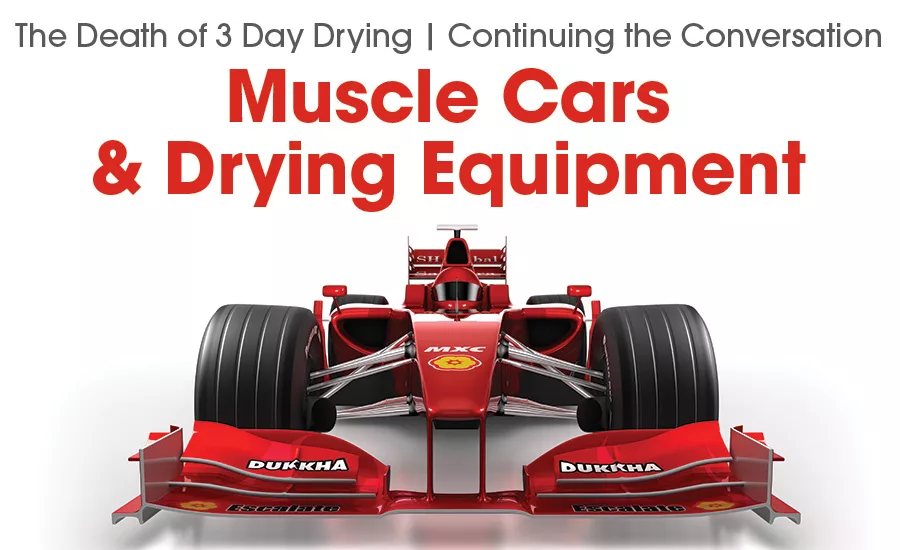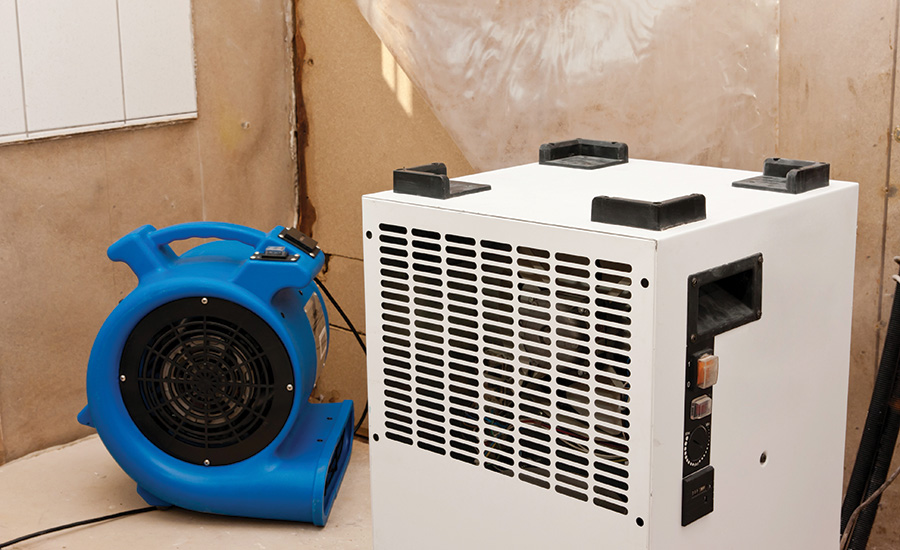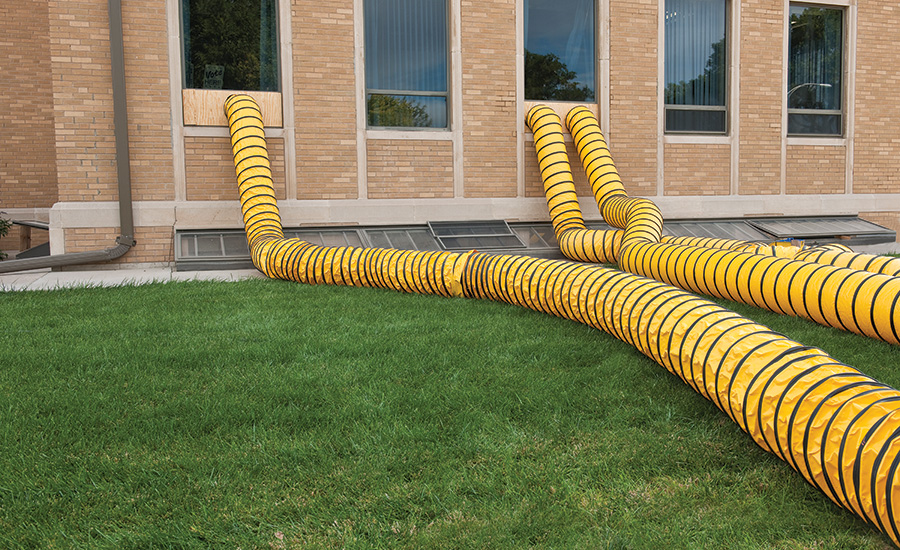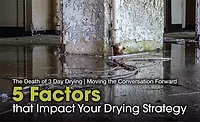The Death of 3 Day Drying: Muscle Cars & Drying Equipment

Editor’s Note:
This is the latest in a series of articles in R&R over the last few years on the myth of three-day drying. To see earlier articles on this topic, visit here.
For years, I have heard restorers and carriers say some pieces of equipment are “specialty equipment”, and I must admit for a bunch of years early in my career, I listened to the crowd. I restricted my use of desiccants, heat, and other “specialty equipment” to those special situations. Companies I worked with as a restorer and consultant did not have those pieces in their fleet which meant that equipment was never utilized. When the customer dictates what equipment is classed as specialized, they place irrational and irresponsible barriers up. The job of the restorer is to educate the customer and restore the building using the best technology for the job.
In order to achieve the results you want in the business, you need to know that the equipment you use matters, and not all equipment is created equally. The better you understand the equipment types, the more effectively you can dry a structure, and the more equipped you are to educate customers.
Dehumidifiers
There are three types of dehumidifiers:
- Conventional Dehumidifiers
- Low Grain Refrigerant Dehumidifiers (LGR)
- Desiccant Dehumidifiers
However, there are only two dehumidifiers that should be used on water damage restoration jobs: LGRs and desiccants.
1. Conventional Dehumidifiers
These dehumidifiers are built for the residential or light commercial work environment to control the humidity. This technology is old, restorative drying technology and with newer innovations, there is almost no place in the restoration market for these today.
You will not find these conventional dehumidifiers in the commercial restoration companies. These units are typically acquired by people who are new to the restoration game and they stay in the company long past the “new” stage of the business. If you own them, sell them to someone for a residential application.
2. Low Grain Refrigerant (LGR) Dehumidifiers
This is by far the most common type of dehumidifier in the restoration market and rental fleets. While there are many variations of this unit from roto-molded plastics, to stainless steel and aluminum housings, the function remains relatively the same.
Today, companies like Phoenix Restoration and Dri-Eaz are making variable speed fans to change the volume and velocity of the air that moves over the coils improving the efficiency of the units.
Many restorers and insurance companies rely on the use of LGR dehumidifiers because there is a lesser chance of over-drying or damaging materials with these units. The industry must then realize that when you use equipment with less drying power, success of drying applications will also be dramatically reduced.
These units are typically best used when the humidity ratios are higher, and you have a temperature range between 75°F and 90°F.
3. Desiccant Dehumidifiers
By many in the industry, these are considered “specialty equipment.” However, if you look at the effective range of the equipment, the desiccant dehumidifier provides the widest range of effective drying techniques and generally will be anywhere from one to two times more effective than an LGR dehumidifier.
Consider the LGR dehumidifier like a Prius. You can put your foot to the floor, and there is still little chance you’ll careen out of control. You will be able to get where you are going, but you will not be breaking any speed limits getting there. For those learning how to drive or how to dry, these are great units. You can give them to an inexperienced operator and if they place them in the environment, they should eventually get the job done.
Desiccant dehumidifiers are muscle cars of the drying world. When you put your foot to the floor, you better know what you are doing and be paying attention or you will find yourself in trouble. This is where desiccants have earned a bad reputation because many restorers learning to dry have resulted in unintended consequences.
The great thing about desiccant dehumidifiers is that although slightly more complex, you can vary and control the unit to help you achieve your desired results. The challenge is that you normally cannot get those results from with a novice restorer at the helm.
The restoration contractor must realize that by limiting the equipment that is placed on the job, the performance of drying is substantially limited. With client expectations of paying for three or four days for the equipment, the reality is that you may have the wrong tools to shorten those drying times.
Based on conversations I’ve had with structural drying expert Chuck Dewald, using the LGR, we are using the sixth to third (depending on conditions) most effective drying equipment, while we are letting the first and third most effective tools sit on the shelf or do not own them at all.
The reality is many are cautious or scared of desiccants (based on their past experience) and by the market themselves from not necessarily having the staff experience and training to apply the technology.

Heaters
Restorers should absolutely be considering heaters as tools on their drying projects, especially to raise the temperature in the initial stage of drying. Reaching the optimal temperatures for drying inside the drying chamber is critical to reaching your drying goals.
The truth is that using heaters in an open or closed drying system can produce amazing results with using or creating very dry, hot air. This is especially true in colder seasons when the humidity ratio outside is low.
If we stick with the car analogy, these are the superchargers that can add power to all forms of drying, even to your Prius.
I would highly recommend if you have not been to a hands-on course at one of the schools who offer the Applied Structural Drying (ASD) class you should go. Recently, I had a chance to visit the Chuck Dewald Structural Drying Academy and would highly recommend you look at that class.
Air Movers
Air movers serve two main purposes on the jobsite. First, they move air to ensure a low-pressure environment is created in the middle of the room to pull moisture from behind the building materials in the stagnant air pockets. Second, they transfer heat energy into the materials that creates an increase in vapor pressure allowing water molecules to be released from the materials.
Getting the proper air movement on a job is critical for restorers. It is important for restorers to recognize that not all air movers are created equally, and the different models do not do the same thing. The three most common types of air movers you will see are centrifugal, axial and radial. Each air mover has a purpose and may be on your vehicles today, but are you really considering their purpose?
1. Axial Air Movers
Axial air movers are the largest made by restoration equipment manufacturers and produce the most cubic footage per minute (CFM). These units also are known for drawing lower amps and generate less noise while allowing you to move larger volumes of air further across wall surfaces.
Restorers are not a fan of these because they are not easily stackable, take up more truck/trailer room, and are harder to carry. But the reality is these units can create improved drying environments and should be part of the restoration contractor’s regular package.

2. Centrifugal Air Movers
The heart and soul of the restoration contractor’s fleet. These air movers have been around for years and while on the outside they may look the same, the performance and design of them is substantially different. There is a major difference between the airflow output of Phoenix or Dri-Eaz-branded equipment, for example, compared to one you will find at a big box store.
The centrifugal air mover design came about when we used to float carpets. That design allowed carpet to rest on the snout and have the air travel beneath. Today, we know wet carpets are very fragile and floating carpet is the quickest way to delaminating and damaging them.
Restorers are also using the air to direct to the bottom of the walls which works but may not work as well as an axial since faster moving air creates the lower pressure to pull standing air into.
3. Radial Air Movers
These air movers are designed around convenience and user experience. They are small, compact, and stack like nothing else. However, they do not move air to the same degree the centrifugal would and nowhere near the axial class performance.
Unlike the conventional dehumidifier, there is a place in restoration for these. But I would classify it as “specialty equipment” because it should be something you use for the right conditions in the right circumstances.
Equipment with a Purpose
Beyond dehus, heaters, and air movers are other tools with specific purposes that can help address specific problems.
Equipment like Injectidry’s floor and wall systems are designed and built to produce negative/positive pressures in hard to dry environments like behind plaster walls, in multiple layers of drywall, concrete block, hardwood floors, or environments needing negative pressure cavities. This equipment has an infrared panel for increasing the surface temperature of a material like stone or ceramic flooring.
Likewise, Drieaz, Phoenix, and Injectidry have various attachments and accessories to add to the equipment in order to change the performance and use of the tools.
E-tes has various heating units that can operate on glycol or utilize a heater combined with an air mover to direct heat to specific surfaces.
The challenge is that while these pieces of equipment are used for specific situations, they are not special tools that should require permission to use. They are special tools designed to dry the structure properly.
Finding Max Drying Potential
Even with the most powerful equipment, you are restricted by how fast the moisture will leave the materials, but it provides you the opportunity to maximize those speed limits. Using under-performing equipment guarantees you will never hit your maximum drying potential.
Equipment that is carefully selected, placed properly on the site, and effectively inspected daily can deliver amazing results, but those results do not guarantee a three-day dry down.
Only restoration professionals who have the knowledge, ability, and confidence to apply the equipment to site will get the best results.
The next time you order an Uber and a Prius shows up, do not ask them to go fast; just be happy it will get you there when you get there.
Looking for a reprint of this article?
From high-res PDFs to custom plaques, order your copy today!





